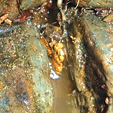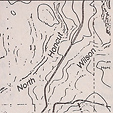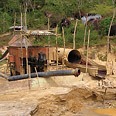All Articles
Legislative and Regulatory Update
October 2002 by Staff
• Financial Guarantees (Bonding)BLM asked us to remind all miners who have a Notice that was on file with BLM on or before January 20, 2001, to apply for an extension of that notice. BLM is allowed to grant an extension on your Notice for up to two years, although the Notice can be extended more than once. To qualify for the extension you must notify BLM in writing and establish a financial guarantee. Until your financial guarantee is approved you may not conduct on-the-ground activities after January 20, 2003. You must take these actions on or before January 20, 2003, for each pre-2001 notice you wish to extend. If you fail to extend your Notice the only work that may be done after January 20, 2003, is reclamation.
This reminder was issued while the debate continues in Washington over financial guarantees. In late July, several mining company executives, and Alaska Mining Association’s own Steve Borell, provided testimony to the House Subcommittee on Energy & Natural Resources for a hearing on the (lack of) “Availability of Bonds to Meet Federal Requirements for Mining, Oil and Gas Projects.” They all testified that insurance companies are no longer selling surety bonds to cover mining and reclamation. Government officials need to act before the January 20, 2003 deadline to avoid a major disruption to the mining industry.
According to Borell, “Congressman Ed Markey (Democrat—Massachusetts) and Jay Insley (Democrat—Washington) made what can only be considered embarrassing cameo appearances at the hearing and railed against the Bush Administration and Department of Interior for ‘weakening’ environmental standards.”
Contact your local BLM office if you have questions. You can also send any constructive comments you may have regarding financial guarantees to the House Subcommittee on Energy & Natural Resources. Contact information is available on our website at www.icmj.com
• National Environmental Policy Act (NEPA)
NEPA, signed into law in 1970, requires an environmental impact statement for development, mining, and other projects. A typical environmental impact statement includes detailed analysis by several federal agencies and extensive public comment. The Bush administration announced they are reviewing the law in hopes of streamlining the process that delays some projects for years.
“The simple fact is, (NEPA) has been used and abused by those who want to obstruct activities,” said Chris West, vice president of the American Forest Resource Council.
Environmental extremists are afraid they will lose some of the regulations they use to sue government agencies and developers.
• Diesel engine exhaust
The Environment Protection Agency (EPA) released the final version of the “Health Assessment Document for Diesel Engine Exhaust.” EPA has recently established new emissions standards for diesel highway vehicle engines that become effective with the 2007 model year. The agency is also developing a proposal to further restrict emissions from off-road vehicles and heavy equipment. This could have a negative impact on miners if not implemented correctly. Older equipment must be “grand fathered” in to avoid excessive losses for current operations. For further information, contact the Technical Information Staff, NCEA-Washington Office (8623D), U.S. Environmental Protection Agency, 1200 Pennsylvania Avenue, N.W., Washington, DC 20460; telephone: 202-564-3261; fax: 202-565-0050; e-mail: nceadc.comment@epa.gov
• Senator Daschle inadvertently helps timber industry
Senate Majority Leader Tom Daschle (Democrat—South Dakota) may have accidentally assisted the timber industry when he attached an amendment to an anti-terrorist bill. The amendment suspends environmental reviews in forests in his home state for timber sales needed for fire prevention. Other members of Congress followed by introducing legislation to extend this same treatment to all states. President Bush followed suit with his Healthy Forests Initiative, intended to streamline the review of forest projects and remove regulatory obstacles in the name of forest fire prevention. The Healthy Forests Initiative, if enacted, would also greatly reduce the number and frequency of lawsuits by environmental extremist groups.
• USFWS implementing Wildlands Project without voter approval
The US Fish & Wildlife Service continues to dish out taxpayer money to implement the Wildlands Project. The Wildlands Project was the brainchild of Earth First! founder and environmental extremist Dave Foreman. Foreman stated, “I suggest that at least half of the land area of the 48 conterminous states should be encompassed in core reserves and inner corridor zones...within the next few decades...assuming that most of the other 50 percent is managed intelligently as buffer zone.”
Foreman’s scheme was embraced by former vice president Al Gore and adopted by the United Nations and documented in their “Agenda 21.” Our elected officials have never approved the Wildlands Project, but it has flourished on the backs of environmental extremists who were appointed to government positions during the Clinton/Gore administration. Dozens of Non-governmental organizations (NGO’s), such as the California Wilderness Coalition, the Southwest Center for Biological Diversity and the Nature Conservancy have taken up the goal of implementing Dave Foreman’s vision. They have continued to use the Endangered Species Act, Habitat Conservation Plans (HCP’s), conversation easements and countless lawsuits to achieve their extremist goals. Their supporters have gained appointments to environmental oversight committees and water councils.
USFWS recently announced that it is awarding $68 million to various states to purchase private property for Habitat Conservation and to conduct additional “studies.” The announcement boasts identical goals to the Wildlands Project and Agenda 21. Regarding an area of San Diego County recommended for purchase, the USFWS states, “This corridor of native habitat is a key linkage between the Multiple Habitat Conservation Program (MHCP) and the Multiple Species Conservation Program (MSCP) because it connects these two planning areas/core habitat areas that are the subject of increasing development pressure. Preservation of this linkage will also conserve unlisted, but vital, species in the ecosystem such as predators and pollinators that play a key role in maintaining healthy populations of the species covered by the Fieldstone HCP.”
USFWS also stated, “There are more than 330 Habitat Conservation Plans currently in effect covering approximately 30 million acres, and some 320 more are being developed.”
Information on environmental extremist groups is available at www.ruralcleansing.com and at www.citizenreviewonline.org
Let our elected officials know it is time to reduce the influence of environmental extremists and NGO’s. Contact information for elected officials is available on our website at www.icmj.com

Melman on Gold & Silver
On a similar vein, while the number of new non-farm jobs created rose by a modest 156,000 in September, it must be pointed out that Goods Production Payrolls rose by only 10,000 jobs while much lower paying service jobs accounted for the other 146,000.
Legislative and Regulatory Update
• GAO opinion contradicts Norton-Leavitt road deal
• Cubin wages battle over public lands decisions
• Washington State rivers are open, work continues
• Recent FWS habitat, endangered or threatened proposals
It Pays to Know Your Bedrock
 On our last trip, we brought ropes and went down the first waterfall forty vertical feet, only to be confronted by a second, sixty-foot-high, overhanging waterfall that emptied into a slot canyon.
On our last trip, we brought ropes and went down the first waterfall forty vertical feet, only to be confronted by a second, sixty-foot-high, overhanging waterfall that emptied into a slot canyon.
Picks & Pans: Gold Mining on Joie Osgood Ranch
 Butte County, California—On January 29, 1978, Peter and I received permission from Joie Osgood to pan and look for gold on her property. The 3800 acre property was located about four miles northeast of Honcut, Butte County, California.
Butte County, California—On January 29, 1978, Peter and I received permission from Joie Osgood to pan and look for gold on her property. The 3800 acre property was located about four miles northeast of Honcut, Butte County, California.
The Guaniamo Diamond Region, Venezuela—Part I
 The considerable richness of the gravels is shown by the fact that operators have successfully worked the same river sections for over 20 years.
The considerable richness of the gravels is shown by the fact that operators have successfully worked the same river sections for over 20 years.
Sulfides and Intergrain Gold Wire Nuggets
 ...these nuggets have not traveled far from the lode because the golden wire lattices would have been torn apart or flattened during weathering of rock and deposition by violent stream action.
...these nuggets have not traveled far from the lode because the golden wire lattices would have been torn apart or flattened during weathering of rock and deposition by violent stream action.
Progressive Privy Program Proved Popular
by Mella Rothwell Harmon
Nevada Department of Museums, Library and Arts
"This was Nevada"
Subscription Required:
The Bawl Mill
• Our Readers Say
• Placer Gold in Idaho
• Working the Belmont Mine Butte, Montana—1953
• Simple Sluice Design
• Cobalt and Nickel in Missouri
• Sunshine Mine Video Brings Back Painful Memories
• Hardrock Detecting
• Gold Garbage: Scams New & Old
• Company Notes
• Picks & Pans: Confessions of a Professional Nuggetshooter
• Gondwana Gold and Diamonds
• Looking Back
• Ghost Towns of Washington County, Utah
• The Fire Within
• 2002 California State Gold Panning Championships—Foresthill, California
• Mining Stock Quotes and Mineral & Metal Prices
• Melman on Gold & Silver
Free:








